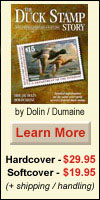 |
10% off on
web orders over $100 |
|
|

|
|
Indian Reservation Stamps
by Pam Johnson
Several tribal governments, since the late 1950s, have issued stamps for hunting and fishing. These stamps help track hunters and anglers while the funds aid in the conservation efforts. Early issues are simple text stamps. Little was known of these issues. Printing was low, usually just enough to satisfy demand by the hunters or anglers.
In recent years the popularity of these issues has grown along with collector interest in all areas of conservation stamps. Stamps have been issued for residents, non-residents, tribal members and non-tribal members. All types of game from small to large have had stamps issued for hunting permits. Popular game include deer, elk, pheasant, grouse, furbearers, turkeys, antelope, and of course ducks.
At this time, the tribes are striving to make the stamps more attractive with adding wildlife art images to the stamps. Mr. Tom Miskey of Chico, Calif., has been commissioned to create pictorial images for several of the tribal issues including Fort Peck, Crow Tribe, and Standing Rock. However, printing quantities of most are still very low.
Many tribes will not sell stamps until the hunting season has passed in order to maintain enough on hand to satisfy hunter demand. The tribes are not staffed or equipped to handle individual collector demand keeping these issues difficult to obtain.
The stamps have been issued in water activated and self-adhesive, perforated, rouletted and imperf. Face values of the stamps vary depending on the license required with large game having the highest fees. More background information and new discoveries surface from time to time as offices are moved or files are cleaned, thus an interesting and always changing area of collecting.
One of the tribal areas that little has been written on, is the Northwest Indian Fisheries Commission located in the western side of the state of Washington.
In 1974, the tribes in this area won a major court ruling (the Boldt Decision) in US vs. Washington. The ruling established the tribes as co-managers of the resource entitled to 50% of the harvestable number of salmon returning to Washington waters.
Following the ruling, the Northwest Indian Fisheries Commission was created to assist them in orderly and sound fisheries. Stamps were issued starting in 1982. The stamps are self-adhesive and are required to be attached to the tribal memberís angler permit, which resembles a driverís license with photo and personal information. The permit stamp allows the member to take salmon/shellfish commercially (and subsistence in some tribes) in their tribeís usual areas.
The Northwest Fisheries consists of five areas; Medicine Creek, Point No Point, Makah, Quinalt, and Point Elliot. Each area may cover from one to nine tribes. Point Elliot has nine tribes and Makah the one individual tribe. The Tulalip tribe is in the Point Elliot area and is the only one known with hunting stamps. The licenses or permits are used over and over with the current yearís stamp applied over the previous yearís stamp. With personal information also contained, stamps on license are extremely scarce, few exist. Very few stamps remain at the end of the season, in most cases, less than 20 stamps are known of these issues.
Shellfish stamps have been issued for the Suquamish tribe in the Point Elliot area starting in 1992. They were replaced in 1997 with the Northwest Indian Fisheries Commission shellfish stamp. With 300 or less printed, they are extremely scarce stamps. The hunting stamps for the Tulalip tribe are required for tribal members to hunt designated game with firearm or archery tackle. The stamps are known to exist since 1988.
Each tribe or tribal cooperative maintains a program to enforce regulations. Tribal member officers work with state and federal enforcement personnel to protect natural resources. Violations are referred to tribal courts for prosecution.
Thanks to Charles Sounder for much of the stamp information in this article. |
 Back | News Page
Back | News Page
|



















